New Forest Autumn Walks
Autumn is a season rich in ripened fruits and rusty shades, and nowhere more so than the New Forest National Park in Hampshire. If you’re thinking of an autumn escape, a long weekend, or quiet, cosy retreat, the New Forest could be your ideal location.
Here, beneath the ancient boughs and mighty oaks, the tracks and trails are being carpeted by the fruits of the forest. Up in the leafy canopies, there are glorious hues of reds and browns, while below, woodland creatures busily stock their larders and feather their nests for the coming winter. Autumn walkers are treated to some spectacular natural spectacles – stags rutting in the heaths and droves of pigs grazing the woodland floors during pannage.
Here is a selection of New Forest autumn walks that encapsulate the national park in all its seasonal glory.
1. Rhinefield Ornamental Drive
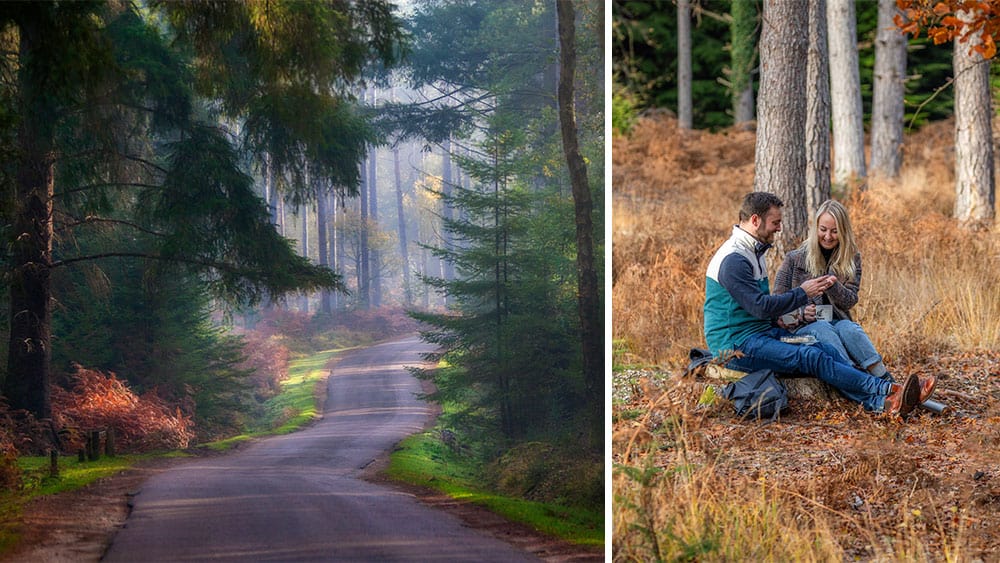
Widely viewed as one of the most spectacular woodland trails in Britain, the Rhinefield Ornamental Drive was established in 1860, part of a weaving route that passes beneath the tallest trees in the New Forest, the giant sequoia redwoods. Also abundant along the ornamental drive are conifers, azaleas and rhododendrons, a dazzling part of this exotic corner which includes the Blackwater Arboretum.
The route is just shy of 11 miles, starting at Brockenhurst and finishing at the timeless village of Burley. Also a cycle trail, you can expect to encounter veteran oaks, ash and beech, and listen out for the bellowing stags on the heathland as you head for Black Knowl on the banks of the Lymington River.
2. Wilverley Inclosure
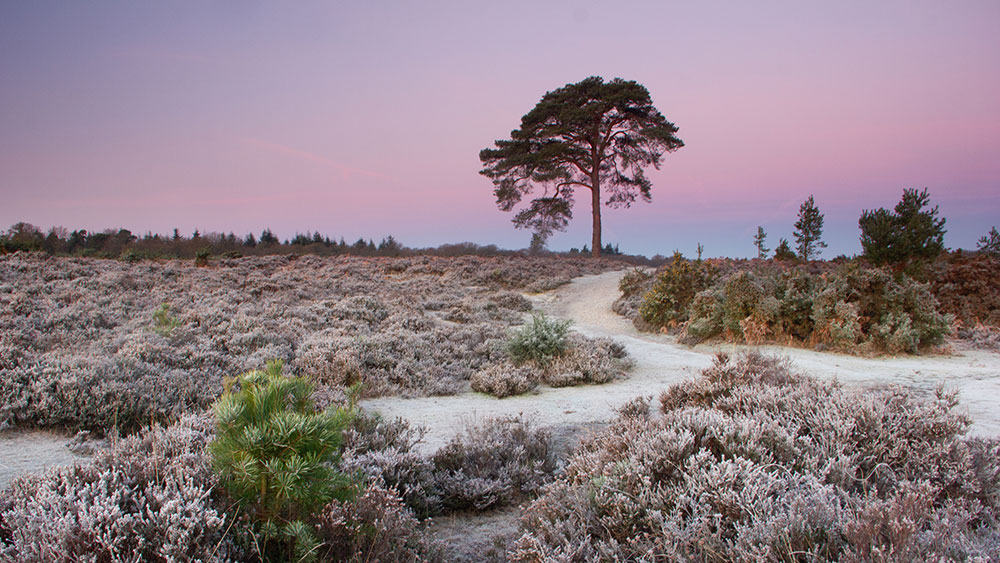
The waymarked trails of Wilverley Plain stretch across 500 acres of ancient woods and heathland, known for its majestic avenues of conifers and its far-reaching views across the old landscape. New Forest ponies are a common sight grazing along the edges of the forest enclosure where the track meanders below the sweet chestnut trees. Red, roe, sika and muntjac deer freely roam the land, look for their cleft hoof prints as a sure sign they’re about. A favourite walk for picnickers, Wilverley is also home to some of the forest’s most important bird species often seen darting through the woodland. Whether you’re travelling on foot or saddled on two wheels, you’ll be struck by these beautiful autumn scenes.
3. Knightwood Oak
Said to be the oldest oak in the national park, earning it the title of “Queen of the forest”, the Knightwood Oak is a magnificent sight found in a hidden clearing off the Bolderwood Ornamental Drive. Protected by a cleft oak fence, the oak is believed to have sheltered King Henry VIII having got caught in a deluge during one of his many hunting expeditions. It’s reckoned to be more than 500 years old and has a girth of more than 70 metres (24 feet) and is still growing! You’ll find yourselves surrounded by a maze of woodland paths waiting to be explored. What better way to celebrate autumn in the New Forest than a visit to one of its most venerable oaks.
4. Rockford Common
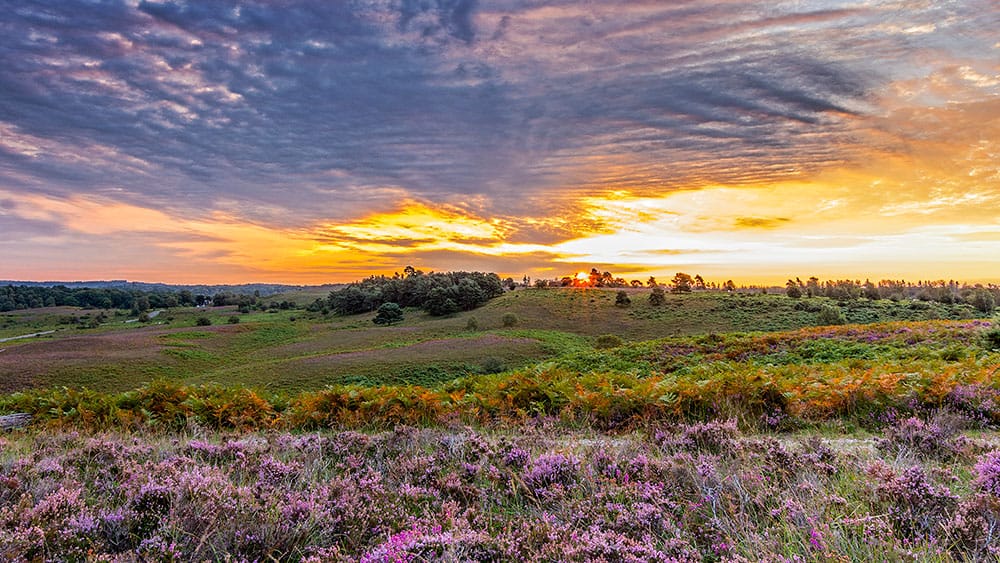
An expanse of woods and heathland, the wildlife at Rockford Common is precious enough for it to be designated as a Site of Special Scientific Interest (SSSI). Explore the common by way of gravel paths along flat terrain, taking advantage of the stopping spots and various points of interest. Wildlife spotters often catch glimpses of the rare silver studded blue butterfly and capture magical images of nightjars and Dartford warblers. East of Mount Farm, the southerly trail sinks into an ancient holloway, a centuries-old route below the tree roots first recorded in the 1700s. This ancient patch is a stunning collage of seasonal colours. Autumn in the fields around Cherry Oaks, not far from the silver birch apiary, sees Gloucester Old Spot pigs foraging during the pannage season, an historic commoner’s right believed to date back to the reign of William the Conqueror.
5. Denny Wood
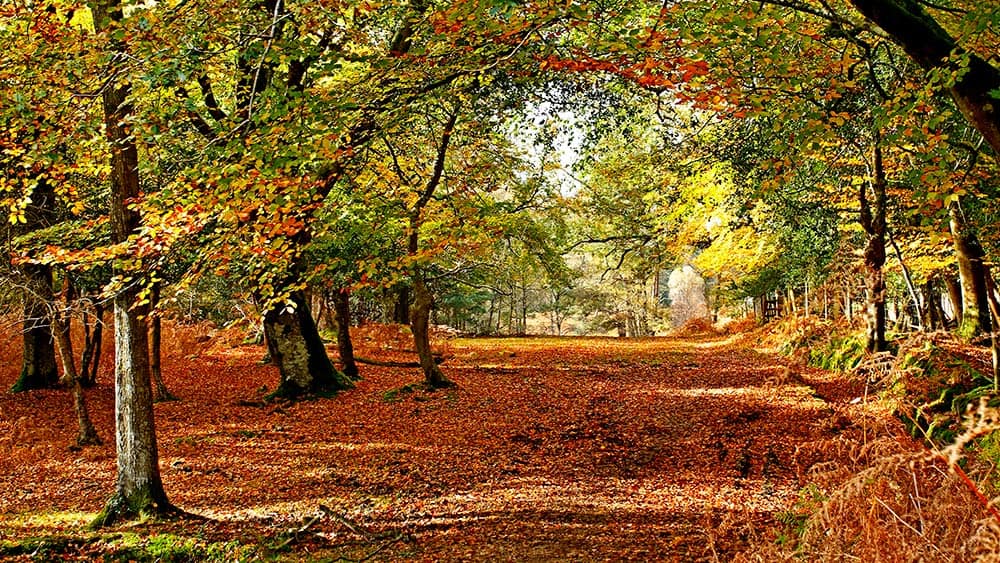
Our next autumn New Forest walk is a circular route through one of the park’s designated ancient and ornamental woodlands, a rich tapestry of bronzing leaves found deep in the heart of this ancient hunting ground. Denny Wood is a cathedral of veteran oak and beech trees. This is the time of year when the stags are rutting and belling, and their haunting bellows can often be heard echoing through the forest.
The waymarks guide you along the old boundaries of the Bishop of Winchester’s purlieu, passing the bishop’s dykes – land steeped in local legend promised to John de Pontoise, a larger-than-life bishop in every sense of the word, who was challenged to stake his claim to the 500 acres on his hands and knees. A footbridge beyond the Bronze Age tumulus signals the entrance to Woodfidley Passage, a landmark grove dappled by beech trees. On entering Denny Wood, you’ll encounter the old forester’s lodge, hidden behind the copper leaves. A brisk walk across the low valley of Shatterford Bottom puts you on track to Beaulieu Road and a friendly wayfarers’ welcome at The Drift Inn.
6. Bolderwood Trail
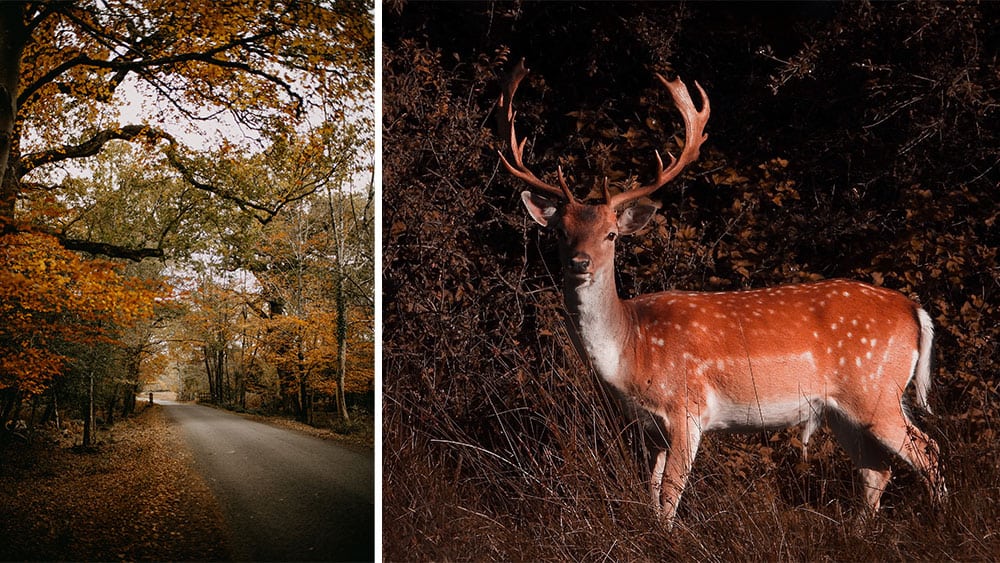
The Bolderwood Trail is a magnificent two-mile way leading you through some of the oldest parts of the forest, starting with the dappled shade of sweet chestnut, oak and beech trees. Set out from the Radnor Stone, a memorial etched in recognition of the 7th Earl of Radnor, Chairman of the Forestry Commission and head of the Verderers (those responsible for maintaining the heritage of the forest). Finding the edge of Mark Ash Wood, with its ornamental canopies, you’ll reach the Bratley Water, as it wends its way to the Blackwater, a popular picnic spot embowered by Norwegian spruce. The final leg of the of the trail arrives at a deer viewing platform where you can quietly watch the resident herd of fallow deer grazings. Fungi are fruiting abundantly during autumn, so keep an eye out for them growing on rotting wood and tree trunks.
7. Fritham
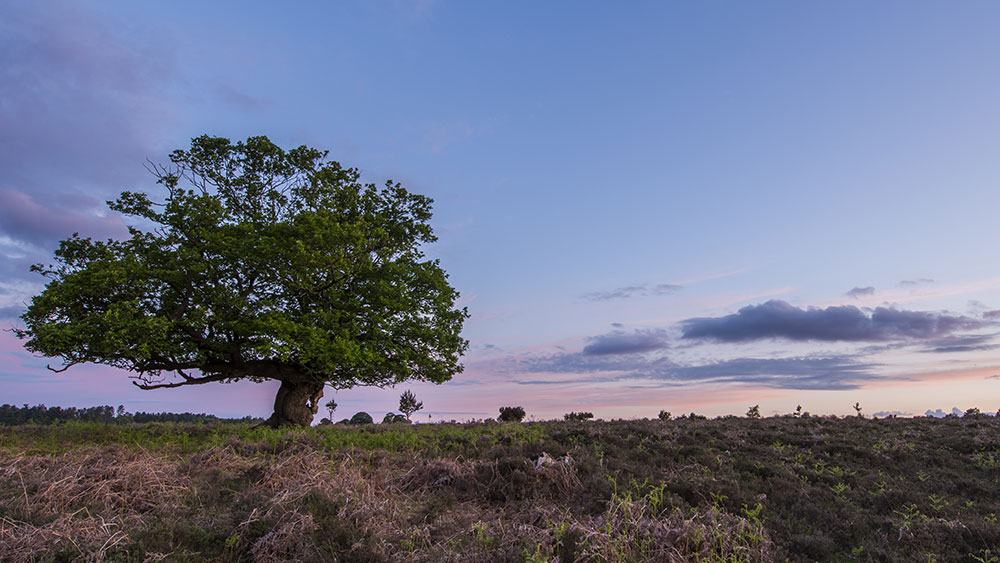
Set in northern heart of the New Forest, Fritham remains one of the park’s most popular walking spots, an enchanting circular walk starting in the village and taking in views across the far reaches of Fritham Plain where the ponies and livestock roam. This invigorating four-mile walk is a tapestry of autumn hues with landmarks and viewpoints at every waymark, from Sloden Enclosure and the slopes of Graze Hill, to Eyeworth Pond, a man-made gunpowder mill pond surrounded by ancient woodlands said to be hiding Roman remains. The much-loved village pub, The Royal Oak, remains a key focal point of this popular walk and cycle path, named after the thousand-year-old English Oak stood opposite.
8. Copythorne and Cadnam Common
Described as a mix of leafy boughs and sun-dappled glades, Copythorne and Cadnam Common conjures up a spellbinding autumn display that extends along riverbanks and woodland rides. This four-mile walk begins at St Mary’s Church then follows the field paths and forest trails to the footbridge crossing the Cadnam River. You’ll find yourselves walking beneath spectacular rhododendrons and across grazing pastures scattered by New Forest ponies in their winter coats. Bar a couple of inclines and muddy puddles, the going is easy along this enchanting walk across a mosaic of landscapes in the grips of autumn.
9. Ashurst
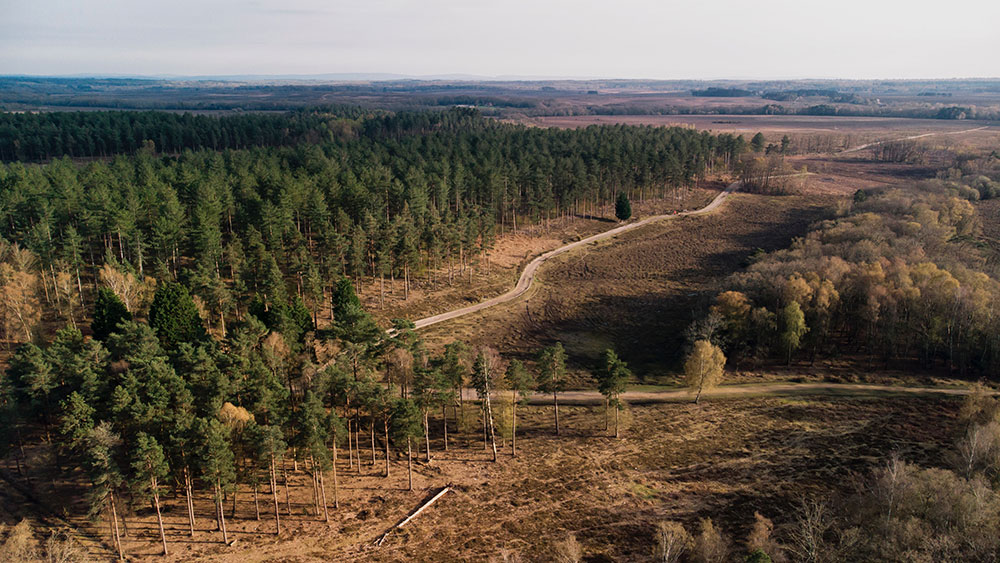
Also encompassing a range of habitats, the Ashurst trail is a three-mile walk through ancient pastures that captures the character of the New Forest. Starting at Ashurst Railway Station, you’ll find yourselves treading the forest lawns, bound for the Churchplace conifer plantation which dominate the skyline with its lofty spires. Ashurst wood is ablaze with the colours of autumn, the oaks home to woodpeckers foraging for their acorns. The woodland road will lead you past the earthwork remains of a saltpetre house. During Tudor times, these woods were once harvested and burnt for saltpetre, the raw material used to make gunpowder and tan animal hides, the remnants of this industry still visible in the pitted earth.
In fact, these woods are pocked and scarred by history, from the ditches and embankments of Church Place knoll, thought to have once been the site of a village church, to the lowland pits just off the green path reckoned to have been dug out for marl; a mix of minerals, clay and silt that was likely used to nourish the fields. This practice remains one of the New Forest’s ancient rights and dates back to the early Saxon forest dwellers. It includes the right to gather fuel and pasture livestock. Such rights remain enshrined in the laws of the forest, upheld by the Commoners, having survived through the centuries.
10. Godshill and Castle Hill
The Godshill and Castle Hill is a peaceful walk along quiet woodland paths and open countryside tracks, with magnificent views across the Avon Valley. Also known as Frankenbury Hill Fort and Godsmanescap, Castle Hill is the site of the largest Iron Age ringfort in the New Forest, described by Historic England as a “slight univallate hillfort”, and considered a rare example of its kind. You can start your walk at the Fighting Cocks pub, then follow the waymarks until you eventually discover Castle Hill hamlet, found tucked away in the lowlands. The Avon Valley sweeps for miles from Salisbury all the way to Christchurch, its famous path taking in the water meadows and riverbanks, a stunning backdrop to the walk. This hearty two-and-a-half-mile route returns you to Godshill having enjoyed a kaleidoscope of autumn colours as far as the eye can see.
11. Rufus Stone
Our next New Forest autumn walk combines seasonal landscape with history and legend. The Rufus Stone walk is a captivating circular route along leafy trails travelling around the banks of Janesmoor Pond and taking in the historic woodlands of the Kings Garn Gutter Inclosure. The Rufus Stone stands in a clearing not far from the village of Minstead. This three-sided pillar is believed to mark the spot where King William II (known to his subjects as William Rufus) drew his final breath after being accidentally shot by a hunting arrow. The fateful arrow was fired by Sir Walter Tyrrell, fizzing past the antlers of its intended target to pierce the king’s chest. It was widely considered an Act of God by the chroniclers of the time, although the king’s unpopularity did rouse suspicion. Sir Walter Tyrrell’s reputation remained untarnished, he’s even had the local pub named after him!
12. Lyndhurst
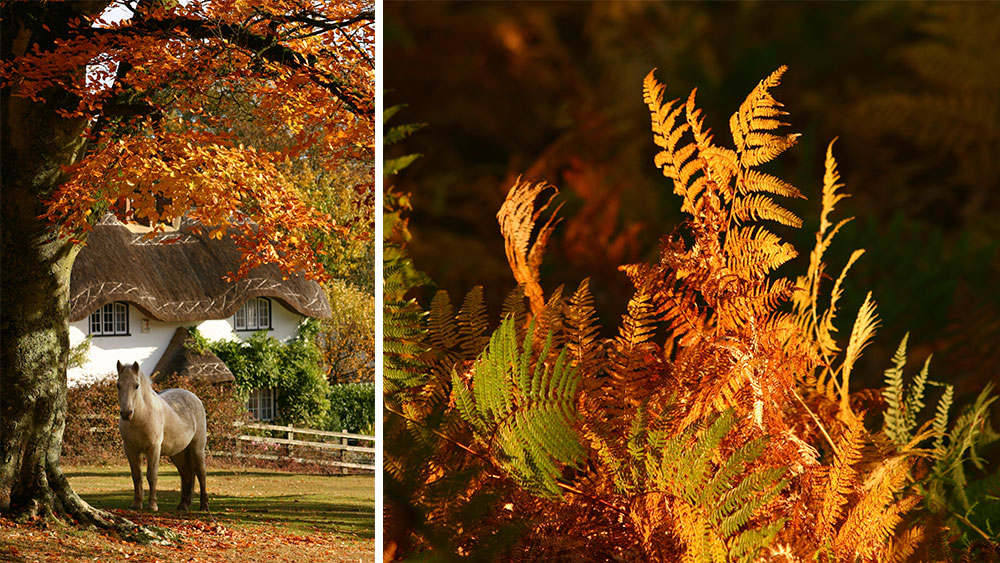
The wonderful Lyndhurst walk follows waymarks along easy going gravel tracks traversing nine-and-a-half miles of Hampshire countryside. The route explores the historic woodland corridor that lies between the villages of Lyndhurst and Brockenhurst, a setting that inspired Lewis Carrol’s Alice in Wonderland. Several cycle routes also encompass this area. Set off from the Pinkney Lane car park, near the Oak Inn, Lyndhurst, and either retrace your route back from Brockenhurst, or catch a bus to halve your ramble. The full walk, there and back, takes approximately four hours. Longer if you stumble upon a Mad Hatter’s tea party!
Discover our collection of over 180 self catering cottages in the New Forest and surrounding coastline. With short breaks, dog friendly cottages and cosy open fires, there’s plenty of place to stay perfect for an autumn escape.
